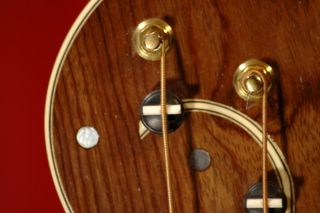Wednesday, July 27, 2005

Solid Koa wood back and sides - beautiful, I hear it is on the endangered wood list now. Koa is from Hawaii and really seems to come alive when you tune down a little bit. No wonder the Hawaiian players discovered the "Slack Key" method of guitar playing! Hard to see but you might notice the center line of the back matches the Rossette design around the soundhole. Classy. Dig that Koa wood grain, sometimes I look at it and weep. I tend to do that with J-lo's backside as well.


The off set saddles make for a better intonated instrument and also give greater clarity and definition between the wound and unwound strings. I have the treble side wired seperate from the bass side so i can play in stereo. This effect coupled together with the banjo tuners glissing notes up and down makes for some very interesting textures and really exagerates the suggestion of two "different" people playing at the same time. I guess there are really, me and my split personality...


A close up of the Banjo tuners with the two (1 black, 1 gold) stop points. The stop points allow a musician to tune up to a pitch, lock the point and then tune down to a specific pitch and lock its point. Now, in theory, you can gliss back and forth between the two pitches very quickly and dare I say "accurately"? Also shown are the Takamine "HAP" tuners. The hole in the middle of the "HAP" tuner allows the player to "unlock" the cap stan of the tuner and adjust its height up or down and by doing so affect the tension of individual strings. Sad to say but Takamine no longer offers these tuners. I don't think many guitarists realized what they did. Lucky for me I bought up a small "stash" before they were all gone. heeheehee...

Wednesday, July 06, 2005

A beautiful shot of the harp guitar. My wife loves the aesthetic of this guitar and when company is coming over she often asks me to place it in our dining room so everyone can see it. Sometimes I just sit and stare at it. Sometimes when my wife is gone I dress it up in her naughty underthings and sit and stare at it. Okay, maybe I just made that last bit up. Maybe...


In the sound hole you can see the magnetic field pickup that captures the string energy of the guitar side of the harp guitar. If you look at the left side of the pickup you can see an appenditure coming off it and pointing down into the guitar, this the "arm" of a choir microphone meant to reference the acoustic cavity of the instrument. I have since moved on to a Sunrise magnetic field pickup (the best) and the Trance Amulet Lens system (also the best). At the time this picture was taken there were 2) Magnetic Field pickups on the sub bass side, 6) hex-a-phonic pickups on the bridge of the guitar side, 1) magnetic field pickup in the sound hole of the guitar side, and 1) Choir microphone inside of the guitar. You think I am serious about nailing the guitars tone? You better believe it!


It was hard to find pickups thin enough to slip under the sub bass strings. These are actually "Floating Jazz Guitar" pickups that I modified to use on the harp guitar. I had to use two of them in a slightly staggered position to cover all of the bass strings. There are two small holes drilled beneath each pickup for the wiring. Ouch!


A up close and personal look at the "hex-a-phonic" pickups on the guitar side of the harp guitar. These pickups offer amazing clarity and string seperation. At the time of this writing I have since moved onward (and upwards!) to the Trance Audio Amulet system which I believe to be the best for the honest reproduction of acoustic guitar tone. I did like the hex pickups quite a bit though, my main beef with them is they did not reference the wood volume of the guitars body which is real important when you slap around on it for percussive effects. I plan on using the hex pickups on the sub bass side of the harp guitar that is currently being built for me, I think they will be perfect for that.


A backwards glance at the headstock from behind. I still get confused sometimes when I try to tune this guitar because it is so easy to grap the wrong tuning machine! Fortunately this out of tune-ness goes nicely with my out of tune vocals! The sub bass headstock tuners were modified with Schaller banjo tuning pegs - kind of pricey but well worth it.


A close up of the two Harp Guitar headstocks. Look closely and you may be able to see where the sub bass headstock actually attaches to the guitar side headstock via a metal bracket. Care must be taken when restringing because the release of string tension causes the headstocks to "drift" apart about a 1/4". The guitar side headstock tuners were modified with Godin tuning machines. Thank you to the folks at Godin who were kind enough to send those to me.









